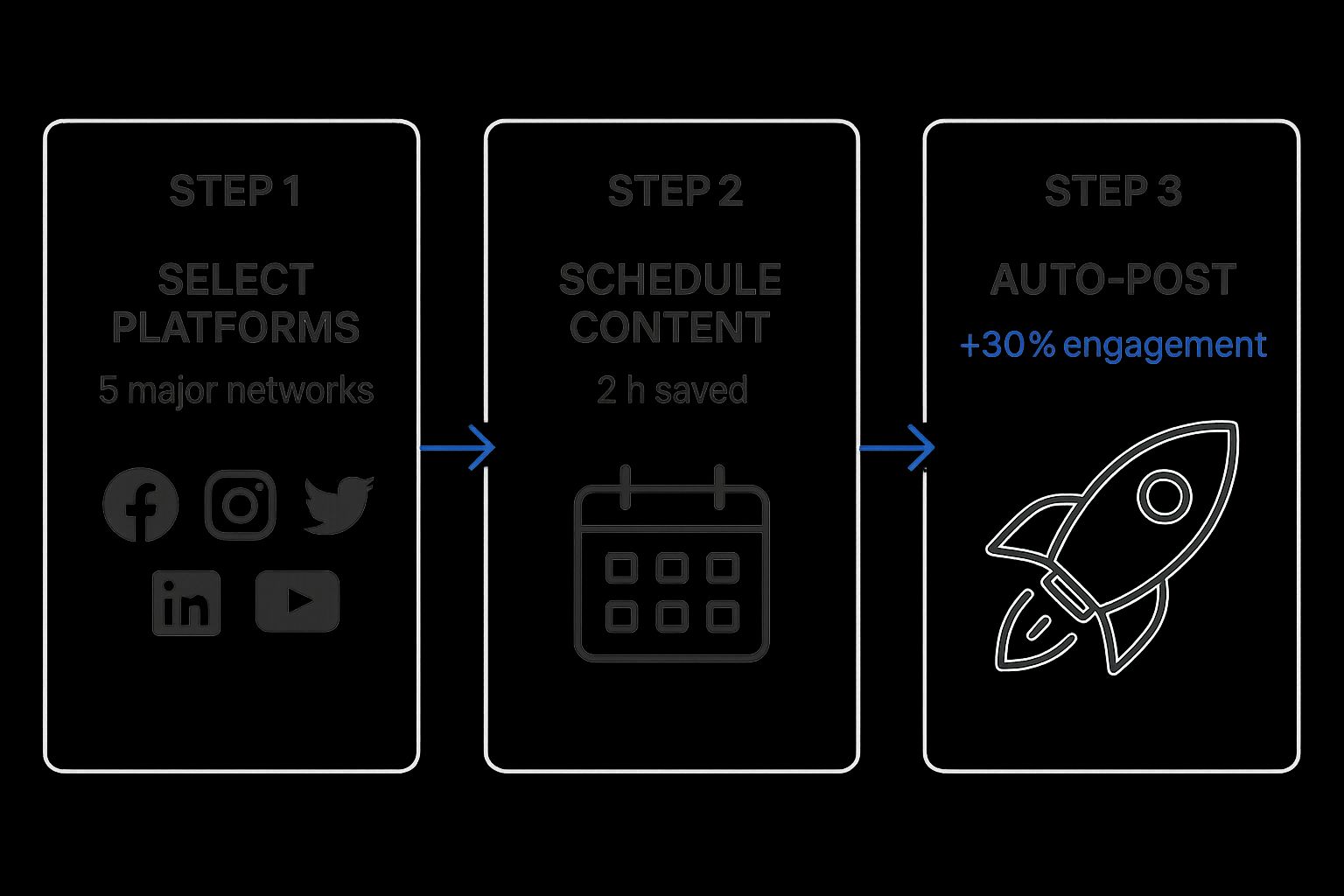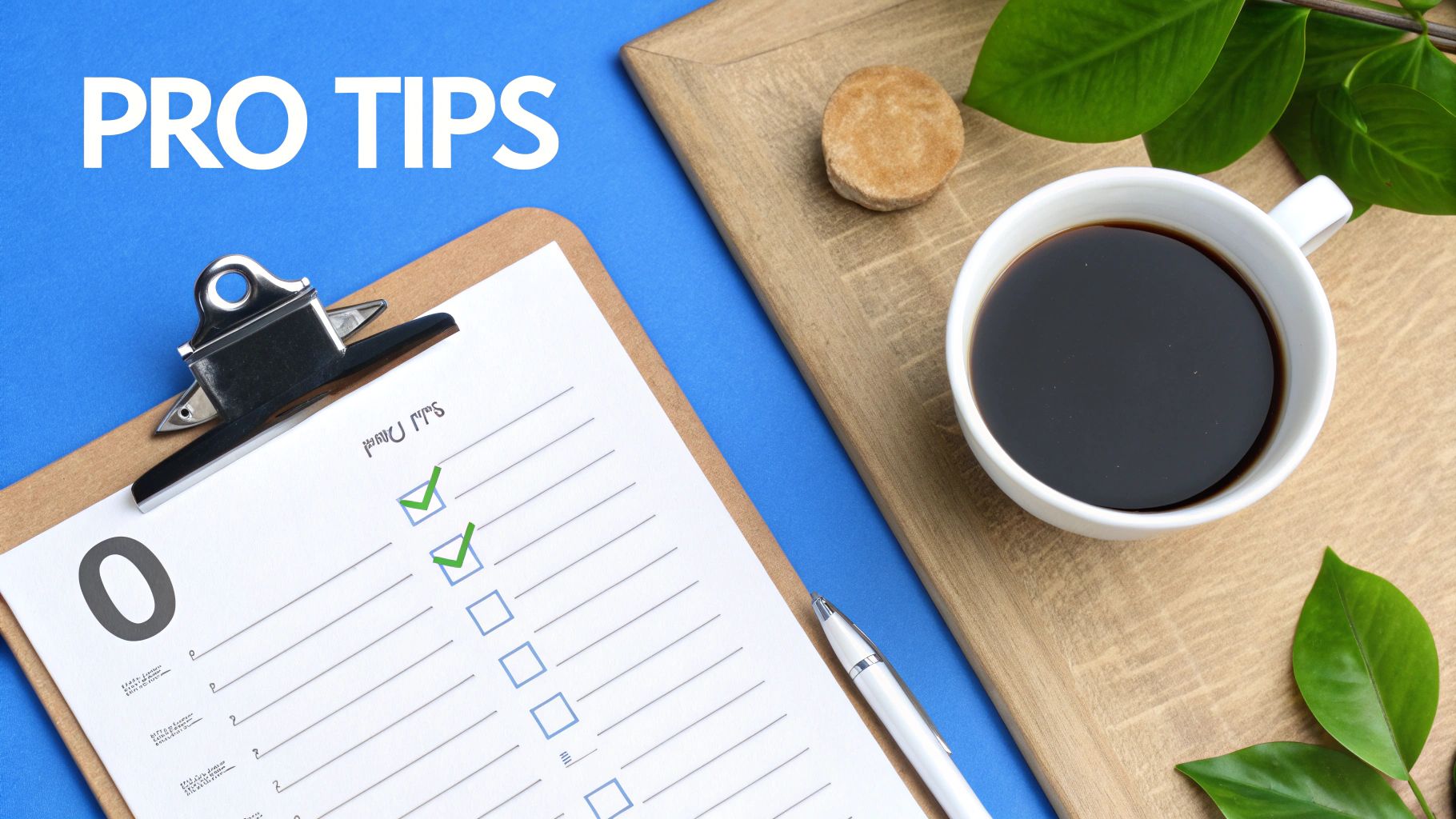Absolutely, you can post to all social media at once—and frankly, you should be. Using a social media management tool is the secret to getting this done without pulling your hair out. It lets you write a post once, then push it out everywhere from a single dashboard. This simple shift turns a mind-numbing, repetitive task into a smart, efficient part of your workflow.
The Reality of Modern Social Media Management

Let’s be real for a second. Juggling multiple social accounts is a grind. You know the drill: log in, log out, copy, paste, tweak the image size, then do it all over again for the next platform. It’s a massive time-sink for any creator, marketer, or business owner. It's not just tedious; it's a terrible use of your time.
This manual, platform-hopping chaos is where things start to fall apart. Branding gets sloppy, your core message gets watered down, and posts end up going live at random times instead of when your audience is actually online. The frustration is real, and it’s a common bottleneck that holds so many people back from growing their presence.
Why A Unified Approach Matters
Adopting a single, unified strategy isn't just about clawing back your time; it’s about making sure you’re seen. Think about it: by 2025, over 5.4 billion people will be on social media, and on average, they're active on seven different platforms each month. Your audience is scattered, and you need a smart way to reach them wherever they are. If you're curious, you can dig deeper into these social media statistics and see what they mean for marketers.
A smart cross-posting strategy allows you to maintain a consistent, professional presence across all channels where your audience spends their time. It turns your social media efforts from a daily chore into a scalable growth engine.
Instead of fighting a losing battle against the clock, using a tool to automate the busywork lets you focus on what really moves the needle: creating great content. When you automate the distribution, you guarantee your message gets in front of the widest possible audience without sacrificing your sanity. This is what effective, modern social media management looks like.
Let's break down exactly why this approach is so effective.
Why Cross-Posting Is a Game Changer
This table gives a quick snapshot of the primary benefits you get when you start posting to multiple social media platforms from one place.
| Benefit | Impact on Your Workflow |
|---|---|
| Time Savings | Dramatically reduces the hours spent logging into and out of different platforms. |
| Consistent Branding | Ensures your message, tone, and visuals are uniform across all channels. |
| Expanded Reach | Puts your content in front of different audience segments on various platforms. |
| Better Scheduling | Allows you to schedule posts for peak engagement times on each network, automatically. |
In short, it’s about working smarter, not harder. You can reclaim your time and energy to focus on strategy and creating content that your audience will actually love.
Finding the Right Social Media Management Tool

Before you can really get the hang of posting to all your social media at once, you need the right command center. The market is packed with options, but the "best" tool isn't found on a top-ten list—it's the one that just clicks with your specific workflow.
Think of it like picking a car. A freelance photographer running a visual-heavy brand needs something with top-notch Instagram and Pinterest scheduling; that's their nimble van for hauling creative gear. On the other hand, a B2B agency focusing on lead gen needs deep LinkedIn analytics and team collaboration tools—their reliable sedan built for business.
Your first move is to figure out your absolute must-haves. It's easy to get distracted by shiny features you'll never touch. Instead, zoom in on the platforms where your audience actually spends their time. Does the tool handle TikTok and Reddit, or is it stuck with the basics?
Key Features to Compare
When you're kicking the tires on different platforms, look past the marketing slogans. The features that really matter are the ones that save you time and headaches every single day.
- Platform Support: Make sure it connects seamlessly with every network you're on. A tool is worthless if it doesn't support a key channel like LinkedIn or Threads where your most valuable conversations are happening.
- Scheduling Depth: Basic scheduling is table stakes. The real game-changers are features like evergreen content queues, drag-and-drop visual calendars, and smart suggestions for the best times to post. These are the things that take the guesswork out of your strategy.
- Analytics and Reporting: A great tool doesn't just push content out; it tells you what’s landing with your audience. How easily can you pull a report comparing engagement on Facebook versus Instagram? Making decisions with real data is what separates the pros from the hobbyists.
Choosing the right tool isn’t about finding the one with the most bells and whistles. It's about finding the one with the right features for your specific goals. It should feel like it's removing friction from your day, not adding another complicated task to your list.
Taking the time to make a smart choice now saves you the massive pain of migrating your entire content calendar down the road. If you need a hand sorting through the options, check out this detailed breakdown of the best social media scheduling tools on the market. It’s a great starting point for finding a platform that will grow with you.
Connecting Your Accounts for a Seamless Workflow
Once you've picked your social media management tool, it's time to lay the groundwork. This is where you connect all of your social media profiles to your new command center, which is what allows you to post to all social media at once. Essentially, you're giving the platform permission to publish content on your behalf.
The process is usually pretty simple, but every social network plays by its own rules. To get everything talking to each other, you'll need a platform that handles these integrations smoothly. For instance, tools like PostOnce are built for connecting social media accounts and managing all those permissions in one spot, so you only have to do the setup once.
Navigating Common Connection Hurdles
While linking accounts is often just a matter of a few clicks, some platforms have specific quirks that can be a real headache if you don't see them coming. Knowing about them beforehand saves you a ton of frustration.
- Instagram's Business Profile Requirement: This is a big one. You can only set up direct, automated posting to an Instagram Business profile, not a personal one. This is a hard-and-fast rule from Meta to access their API, so there's no way around it.
- Facebook Page vs. Profile: In the same vein, most management tools are designed to connect with Facebook Pages, not personal profiles. This keeps things aligned with Facebook's terms of service for commercial activity.
- Two-Factor Authentication (2FA): If you have 2FA turned on (and you absolutely should for security), expect an extra step. When you go to authorize the connection, you'll likely be asked for a code from your authenticator app to prove it's really you.
This simple flow chart really captures the power of what you're building by connecting your accounts and scheduling your content.

As you can see, linking your accounts is the critical first move toward saving hours and driving more engagement through smart, automated posting.
Key Takeaway: The whole point here is to create a single dashboard where all your social channels live. Once they're all connected, you can stop bouncing between different apps and websites to manage your online presence. That's the real magic of this whole strategy.
Crafting Content That Resonates Everywhere
The biggest trap in cross-posting is treating every social media platform like it’s the same. Just blasting the exact same message across the board is a surefire way to kill your engagement and look like you don't know what you're doing. The real art is creating one solid "master post" and then tweaking it to fit the unique vibe of each network.
Think of your core message—your new blog post, a product launch, or a company update—as your starting point. On a platform like LinkedIn, you'll want to frame it with a professional slant, highlighting the business value. But when you move over to Facebook, you’ll shift to a more conversational, community-focused tone. And for Instagram? It's all about that killer visual, with a caption and hashtags that complement it, not lead it.
Tailoring Your Message for Each Audience
Adapting your content isn't just about swapping out a few words in the caption. It's about tapping into the specific features and user habits that make each platform tick.
- Play to Their Strengths: Run a poll on X to get quick feedback, build a multi-image carousel on LinkedIn to walk through a process, or create a trending Reel for Instagram. The algorithms on these platforms reward you for using their native tools.
- Optimize Your Visuals: That beautiful landscape image that looks perfect on Facebook is going to get butchered by Instagram's vertical feed. Take a moment to resize your visuals for each platform's optimal dimensions—it makes a world of difference.
The goal is to make your automated content feel native, not robotic. Each post should look like it was thoughtfully crafted for the platform it’s on, even if it all started from one idea in your dashboard.
This isn’t just guesswork; the data backs it up. We know TikTok boasts incredibly high organic engagement, while multi-image posts on LinkedIn can hit engagement rates of 6.6% for B2B brands. Ignoring these nuances is like leaving money on the table.
Diving into a few more social media platform statistics can really help fine-tune your approach. Ultimately, this is what separates genuine connection from just spamming your followers' feeds.
Taking Your Social Media Automation to the Next Level

Alright, your accounts are all linked up. Now, the real fun begins. We’re moving past basic scheduling and diving into what genuine automation looks like. This is how you stop thinking post-by-post and start building a smart, cohesive content machine that works for you.
The best tools give you a visual content calendar, which is a total game-changer. Suddenly, you can see your entire strategy laid out at a glance. You can also set up content queues for your evergreen material—think customer testimonials, handy tips, or behind-the-scenes stuff—that automatically plug any holes in your schedule. This keeps your feed active and consistent without you having to scramble for content.
Fine-Tuning Your Content Strategy
To really get the most out of automation, you need to be strategic. A simple but powerful trick I’ve found is using content tags to keep your post mix balanced. It’s an easy way to make sure you’re not just spamming your audience with sales pitches.
Here’s a practical breakdown:
- Promotional: Tag anything related to a product launch, a sale, or a special offer.
- Educational: Use this for posts that teach your audience something valuable and position you as an expert.
- Community: This tag is perfect for user-generated content, polls, or questions that get people talking.
This method keeps your feed interesting and builds a stronger connection with your followers. Many platforms now have AI that suggests the "best time to post," taking the guesswork out of hitting your audience when they're actually online. For a deeper dive into these techniques, this guide to automated social media posting offers some excellent, practical strategies.
The secret weapon here is analyzing your cross-channel reports. You stop guessing what works and start seeing, with hard data, which content formats kill it on which platforms. That's how you refine your strategy and get better results.
This data-driven approach is what separates the pros from the amateurs. It’s no surprise that brands with solid cross-channel strategies report customer retention rates as high as 89%. Why? Because consistent, relevant messaging builds trust and loyalty over time.
To learn more about putting this into practice, check out our own guide to https://postonce.to/blog/automatic-social-media-posting.
Your Top Cross-Posting Questions, Answered
Once you start setting up a cross-posting workflow, a few questions always come up. It's totally normal to wonder about the finer points of posting everywhere at once. Let's dig into a couple of the most common ones I hear.
Is It a Bad Idea to Post the Exact Same Thing Everywhere?
Honestly, it can be. Just blasting the identical message and image across every network without a second thought often feels robotic to your followers, and the engagement numbers usually reflect that. Each platform has its own vibe, its own algorithm, and its own audience expectations.
The trick isn't to create entirely new content for each channel, but to make smart, small adjustments. I call this strategic adaptation.
For example, you might shorten your caption for Twitter, use more professional hashtags on LinkedIn, and add a more personal, story-driven caption on Instagram. It’s a small bit of upfront effort that pays off big time by making your content feel right at home on each platform.
It's all about customizing, not just copying. The goal is to make your content look and feel native, like it was made specifically for the audience scrolling that feed.
Can I Really Post to Instagram Stories and TikTok at the Same Time?
Yes, but this is where you need to pay close attention to the tool you're using. Many modern scheduling platforms now support short-form video like Instagram Stories, Reels, and TikToks, but how they do it varies a lot.
Some tools offer true, hands-off automation where it all goes live without you lifting a finger. Others use a semi-automated approach, sending a push notification to your phone when it's time to post. You then just have to tap a few buttons to finish the job.
Before you commit to a tool, double-check its specific video features. You can learn more by checking out these best practices for crossposting on social media platforms.
Ready to ditch the endless copy-and-paste cycle and grow your brand the smart way? With PostOnce, you can create your content once and let automation handle the rest. Get started with PostOnce today and take back your time.